Multiple ATR-Chk1 pathway proteins preferentially associate with checkpoint-inducing DNA substrates
- PMID: 21829571
- PMCID: PMC3146532
- DOI: 10.1371/journal.pone.0022986
Multiple ATR-Chk1 pathway proteins preferentially associate with checkpoint-inducing DNA substrates
Abstract
The ATR-Chk1 DNA damage checkpoint pathway is a critical regulator of the cellular response to DNA damage and replication stress in human cells. The variety of environmental, chemotherapeutic, and carcinogenic agents that activate this signal transduction pathway do so primarily through the formation of bulky adducts in DNA and subsequent effects on DNA replication fork progression. Because there are many protein-protein and protein-DNA interactions proposed to be involved in activation and/or maintenance of ATR-Chk1 signaling in vivo, we systematically analyzed the association of a number of ATR-Chk1 pathway proteins with relevant checkpoint-inducing DNA structures in vitro. These DNA substrates included single-stranded DNA, branched DNA, and bulky adduct-containing DNA. We found that many checkpoint proteins show a preference for single-stranded, branched, and bulky adduct-containing DNA in comparison to undamaged, double-stranded DNA. We additionally found that the association of checkpoint proteins with bulky DNA damage relative to undamaged DNA was strongly influenced by the ionic strength of the binding reaction. Interestingly, among the checkpoint proteins analyzed the checkpoint mediator proteins Tipin and Claspin showed the greatest differential affinity for checkpoint-inducing DNA structures. We conclude that the association and accumulation of multiple checkpoint proteins with DNA structures indicative of DNA damage and replication stress likely contribute to optimal ATR-Chk1 DNA damage checkpoint responses.
Conflict of interest statement
Figures
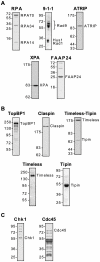
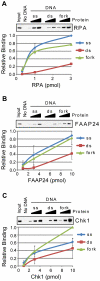
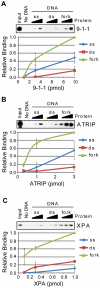

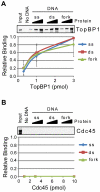


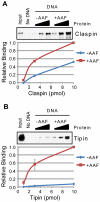

Similar articles
-
The DNA damage response kinases DNA-dependent protein kinase (DNA-PK) and ataxia telangiectasia mutated (ATM) Are stimulated by bulky adduct-containing DNA.J Biol Chem. 2011 Jun 3;286(22):19237-46. doi: 10.1074/jbc.M111.235036. Epub 2011 Apr 12. J Biol Chem. 2011. PMID: 21487018 Free PMC article.
-
Reconstitution of human claspin-mediated phosphorylation of Chk1 by the ATR (ataxia telangiectasia-mutated and rad3-related) checkpoint kinase.J Biol Chem. 2009 Nov 27;284(48):33107-14. doi: 10.1074/jbc.M109.064485. Epub 2009 Oct 14. J Biol Chem. 2009. PMID: 19828454 Free PMC article.
-
Separation of intra-S checkpoint protein contributions to DNA replication fork protection and genomic stability in normal human fibroblasts.Cell Cycle. 2013 Jan 15;12(2):332-45. doi: 10.4161/cc.23177. Epub 2012 Jan 15. Cell Cycle. 2013. PMID: 23255133 Free PMC article.
-
The ATM-Chk2 and ATR-Chk1 pathways in DNA damage signaling and cancer.Adv Cancer Res. 2010;108:73-112. doi: 10.1016/B978-0-12-380888-2.00003-0. Adv Cancer Res. 2010. PMID: 21034966 Review.
-
Evidence that the ATR/Chk1 pathway maintains normal replication fork progression during unperturbed S phase.Cell Cycle. 2006 Oct;5(19):2203-9. doi: 10.4161/cc.5.19.3256. Epub 2006 Oct 1. Cell Cycle. 2006. PMID: 16969104 Review.
Cited by
-
Intramolecular Binding of the Rad9 C Terminus in the Checkpoint Clamp Rad9-Hus1-Rad1 Is Closely Linked with Its DNA Binding.J Biol Chem. 2015 Aug 7;290(32):19923-32. doi: 10.1074/jbc.M115.669002. Epub 2015 Jun 18. J Biol Chem. 2015. PMID: 26088138 Free PMC article.
-
Transcriptome alteration spectrum in rat lung induced by radiotherapy.Sci Rep. 2019 Dec 23;9(1):19701. doi: 10.1038/s41598-019-56027-4. Sci Rep. 2019. PMID: 31873113 Free PMC article.
-
Treatment of human cells with the anti-cancer drug cisplatin results in the caspase-dependent release of adduct-containing cell-free DNA.DNA Repair (Amst). 2025 Jul;151:103855. doi: 10.1016/j.dnarep.2025.103855. Epub 2025 Jun 12. DNA Repair (Amst). 2025. PMID: 40513340 Free PMC article.
-
The role of master regulators in the metabolic/transcriptional coupling in breast carcinomas.PLoS One. 2012;7(8):e42678. doi: 10.1371/journal.pone.0042678. Epub 2012 Aug 27. PLoS One. 2012. PMID: 22952604 Free PMC article.
-
Combined genotoxic effects of a polycyclic aromatic hydrocarbon (B(a)P) and an heterocyclic amine (PhIP) in relation to colorectal carcinogenesis.PLoS One. 2013;8(3):e58591. doi: 10.1371/journal.pone.0058591. Epub 2013 Mar 6. PLoS One. 2013. PMID: 23484039 Free PMC article.
References
-
- Reardon JT, Sancar A. Nucleotide excision repair. Prog Nucleic Acid Res Mol Biol. 2005;79:183–235. - PubMed
-
- Sancar A, Lindsey-Boltz LA, Unsal-Kacmaz K, Linn S. Molecular mechanisms of mammalian DNA repair and the DNA damage checkpoints. Annu Rev Biochem. 2004;73:39–85. - PubMed
-
- Liu P, Barkley LR, Day T, Bi X, Slater DM, et al. The Chk1-mediated S-phase checkpoint targets initiation factor Cdc45 via a Cdc25A/Cdk2-independent mechanism. J Biol Chem. 2006;281(41):30631–30644. 10.1074/jbc.M602982200. - PubMed
Publication types
MeSH terms
Substances
Grants and funding
LinkOut - more resources
Full Text Sources
Miscellaneous

